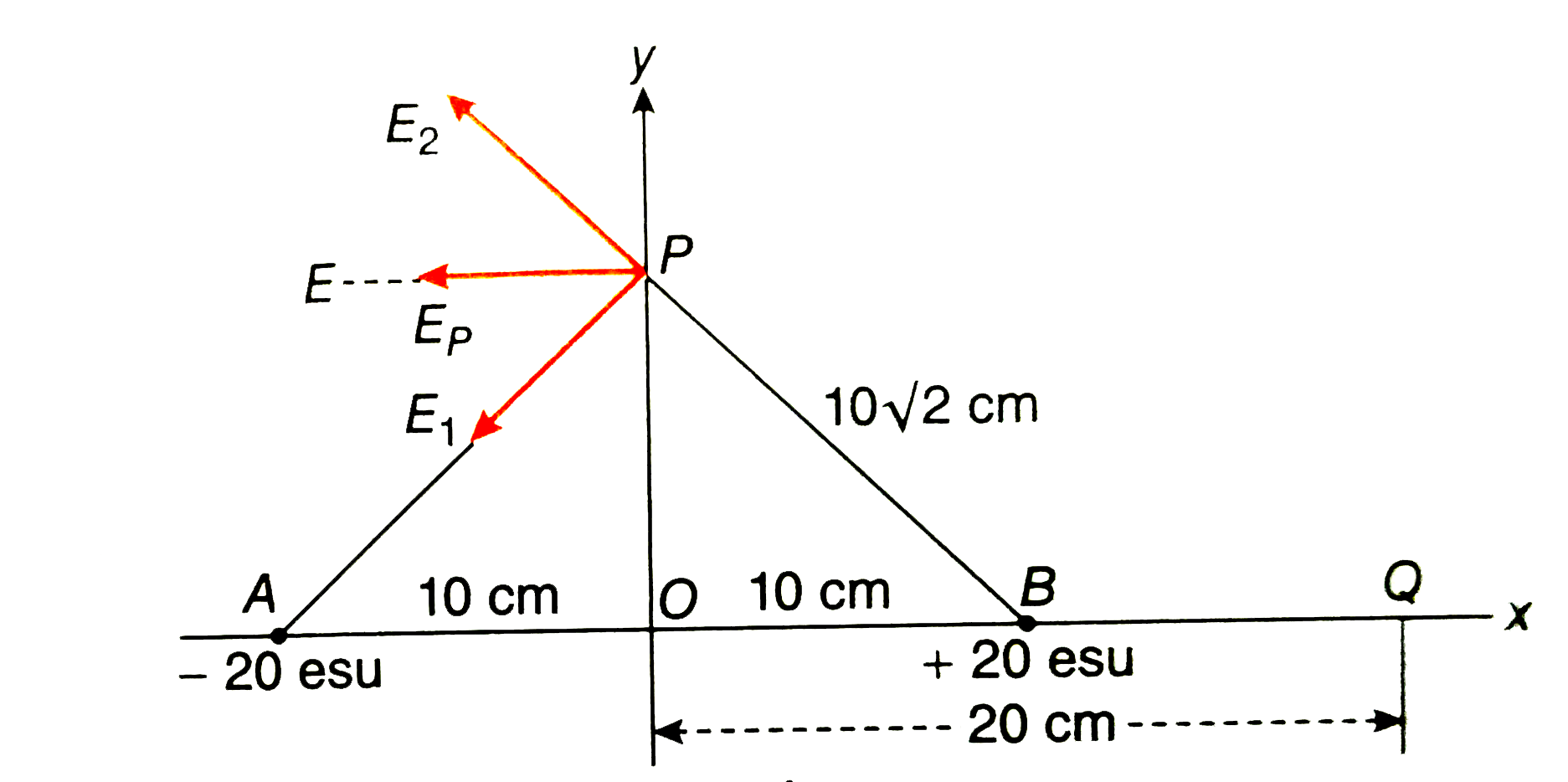Two point charges of values -20 esu and +20 esu are placed on the x-axis at x=−10cmandx=+10cm respectively. Calculate
The potentials at the middle of themSolution in Bengali
Two charges + 20 esu and -20 esu are placed at A and B respectively.
(i) Coordinates of P are (0,10).
Thus, AP=BP=√102+102=10√2cm.

Potential at P,VP=−20AP+20BP=0
Coordinates of Q are (20,0).
So, AQ=30cmandBQ=10cm
Thus potential at Q,
VQ=20BQ−20AQ=2010−2030=43=1.33esu.
Topper's Solved these Questions
- ELECTRIC POTENTIAL BOOK - CHHAYA PUBLICATIONCHAPTER - ELECTRIC POTENTIAL EXERCISE - Section related questions
25 Videos
- ELECTRIC POTENTIAL BOOK - CHHAYA PUBLICATIONCHAPTER - ELECTRIC POTENTIAL EXERCISE - Higher order thinking skill (HOTS) questions
23 Videos
- ELECTRIC FIELDBOOK - CHHAYA PUBLICATIONCHAPTER - ELECTRIC FIELDEXERCISE - CBSE SCANNER
31 Videos
- ELECTROMAGNETIC INDUCTION & ALTERNATING CURRENTBOOK - CHHAYA PUBLICATIONCHAPTER - ELECTROMAGNETIC INDUCTION & ALTERNATING CURRENTEXERCISE - CBSE SCANNER
28 Videos
Similar Questions
What do you mean by potential of a charged body?
View SolutionIf the intensity at a point in an electric field is zero, will the electric potential be also zero at that point? If the electric potential be zero at a point, will the intensity be also zero at the point?
View SolutionA charge q is placed at the centre of a cube of side l. What is the electric flux passing through each face of the cube?
View SolutionA bar magnet is moved in the direction indicated by the arrow between two coils PQ and CD. Predict the directions of induced current in each coil.

View SolutionTwo point charges of +49 esu and +81 esu are placed at a separation of 100 cm in air. Determine the position of the neutral point in the electric fields of the two charges. What is the electric potential at the natural point?
View SolutionAt each of the four vertices of a square of side 10 cm, four positive charges each of 20 esu are placed. Find the potential at the point of intersection of the two diagonals.
View SolutionFour point charges of +100 esu,-50 esu +20 esu and +30 esu are placed respectively at the four vertices A,B,C,D of a square of side 10 cm. Find the electric intensity and potential at the point of intersection of the diagonals.
View SolutionTwo point charges of values -20 esu and +20 esu are placed on the x-axis at x = -10cm and x = +10cm respectively. Calculate (ii) The electric fields at the points P(1,10) and Q(20,0) .
View SolutionTwo point charges of values -20 esu and +20 esu are placed on the x-axis at x = -10cm and x = +10cm respectively. Calculate (iii) Find the work done in carrying a positive charge of value +6 esu from P to Q along a straight the joining them.
View SolutionTwo point charges of values -20 esu and +20 esu are placed on the x-axis at x = -10cm and x = +10cm respectively. Calculate (iv) Is there any path along which the work done is less than the above value ? Why?
View SolutionA negative charge of 30 esu is at a distance of 30 cm from a positive charge of 20 esu. What is the potential at a point 10 cm from the first charge on the line joining the two charges? Where will the potential be zero?
View SolutionA metal sphere of radius 10 cm is charged up to a potential of 80 esu. After sharing its chage with another sphere, the common potential of them becomes 20 esu. What is the radius of the second sphere ?
View SolutionIf 1μC=x esu of charge , what is the value of x?
View SolutionTwo point charges +4 esu and +9 esu are placed 10 cm apart. At what point on the line joining them will a unit positive charge experience (i) an equal but opposite and (ii) an equal and unidirectional force?
View SolutionABCD is a square of side 4 cm. +16 esu, −16 esu and +32 esu charges are placed at the points A, C and D respectively. Determine the resultant intensity at B.
View Solution
